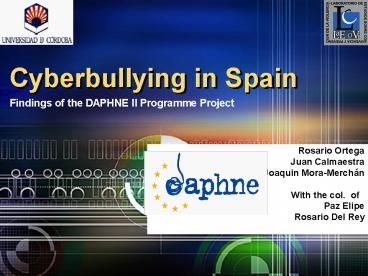Cyberbullying in Spain - PowerPoint PPT Presentation
1 / 21
Title:
Cyberbullying in Spain
Description:
Cyberbullying in Spain Findings of the DAPHNE II Programme Project Rosario Ortega Juan Calmaestra Joaquin Mora-Merch n With the col. of Paz Elipe – PowerPoint PPT presentation
Number of Views:186
Avg rating:3.0/5.0
Title: Cyberbullying in Spain
1
Cyberbullying in Spain
- Findings of the DAPHNE II Programme Project
Rosario Ortega Juan Calmaestra Joaquin
Mora-Merchán With the col. of Paz
Elipe Rosario Del Rey
2
METHOD Sample
- 1671 students (7 Secondary and High Schools)
- Age (M) 14.45
- 94.1 Owns a Mobile Phone
- 82.7 Has access to a Computer
3
VICTIMS AGGRESSORS
- Cyberbullying
Mobile phone Internet TOTAL
Occasional Aggressor 4.2 3.6 6.7
Occasional Victim 3.7 6.2 8.3
Severe Aggressor 0.9 1.0 1.5
Severe Victim 0.5 1.3 1.7
TOTAL 9.3 12.1 18.2
4
VICTIMS
1 or 2 2 or 3 times a moth 1 a week Several times a week TOTAL
Victims of Direct Bullying 7,5 1,3 1,1 0,8 10.7
Victims of Indirects Bullying 12,4 1,7 0,8 1 15.9
Cybervictims Mobile phone 3,7 0,3 0,1 0,1 4.2
Cybervictims Internet 6,2 0,5 0,2 0,6 7.5
Occa.
Severe
7.5
3.2
12.4
3.5
0.5
3.7
6.2
1.3
5
Age Direct Bullying
6
Age Indirect Bullying
7
AgeVía mobile phone
8
Agevia the Internet
9
Overlapping in victimization experiences
10
Emotional profiles(only victims)
- DIRECT BULLYING
11
Emotional Profiles of Indirect and Cybervictims
Internet
- Indirect Bullying
Mobile phone
12
Conclusion and Discussion
- The emotional profiles of cybervictimitation are
similar to the indirect bullying. - The cyberbullying could be characterized as an
indirect form of bullying (Slonje Smith, 2008). - How can we interpreted the differences found
between emotional profiles in direct bullying and
in the other types of bullying? - Heterogeneity of behaviours included in direct
bullying - The face-to-face characteristic could make the
emotional information in the interactions
episodes more readable.
13
SUMMARY
- Prevalence of cyberbullying in Spanish young
people is still lower than the traditional
bullying (nearly half of the traditional
cybervictims). - Instant Messaging (Internet) and nasty call
(mobile phone) are the most common form of
cyber-harassment. - Gender -as traditional bullying- is important,
but age does not follow the traditional trends
(to peak on 15 year old using mobil phone and
maintenance by using the Internet). - Lasting of cybervictimization is shorter than in
traditional one. - A high numbers of cyberaggressors remain on
anonimity (specially using the Internet) - An small group of students overlap, suffering all
kind, traditional and cyber, victimisation.
14
Cyberbullying in adolescence investigation and
intervention in six European Countries
III
- Rosario Ortega
- Rosario Del Rey
- Juan Calmaestra
- Jose Antonio Casas
- Marta Villodre
With collaboration Joaquín Mora-Merchán Paz Elipe
15
Contributions to Daphne III
- Aims
- Investigation
- Intervention
- Dissemination
16
Investigation
- The Spanish team has already collected 1669
Daphne questionnaires from 7 secondary and high
schools. Are more necessaries?
1º ESO 3º ESO 1º BACH Total
Boy n 300 267 290 857
Boy 55,8 50,1 48,5 51,3
Girl n 238 266 308 812
Girl 44,2 49,9 51,5 48,7
Total n 538 533 598 1669
Total 100,0 100,0 100,0 100,0
17
Investigation
- Having in mind the intervention we would like to
administrate to the students - Interpersonal Reactivity Index (IRI) on Internet.
Adaptation of the Davis (1980, 1983) IRI,
validated to study empathy and pro-social
behaviour linked - CAPIC Questionnaire about self-steem, prosocial
behaviour, internet compulsive use and
cyberbullying. - Discussing group about positive uses of ICT and
about how can be used to cope with cyberbullying.
18
Intervention
- Based on the pro-social use of Internet.
- Aims
- to develop adolescent pro-social behaviour
- to reduce adolescent anti-social behaviour
- to reduce adolescent implication in cyberbullying
19
Intervention
- Beginning of October pre-test in three secondary
schools - From October until May develop of the
intervention - Students
- Teachers
- Parents
- End of May Pos-test
20
Material
- New materials
- Protocol of cyberbullying designed with a
multidisciplinary groups of professionals
(EMICI) lawyer, journalist, computer
Technician,
21
Dissemination
- Edition of material for students, teachers and
parents - Participation in International Congress
- Final seminar
- Articles































